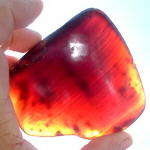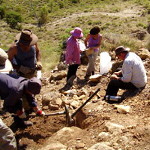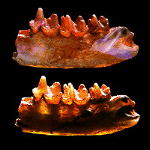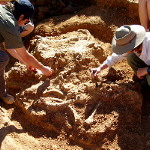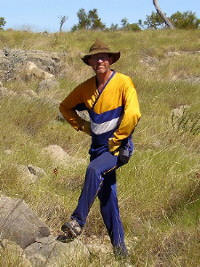 Phil Creaser in the field. |
Creaser digs deep to CREATEDan Gaffney Wily public servant, accidental vertebrate palaeontologist, and widely regarded as a "good bloke", Phil Creaser has acquired a new epithet: philanthropist. He has made a significant donation to establish the CREATE Foundation under the UNSW Foundation to foster research into the evolution of Australia's unique ecosystems. His donation will support research and discoveries flowing from a handful of iconic Australian fossil fields such as those at Riversleigh and Lightning Ridge. Aged 57, Creaser says his long association and friendship with UNSW Dean of Science, Professor Mike Archer, and Suzanne Hand and Henk Godthelp spurred his donation. "Mike, Suzanne and Henk have been warm friends and generous colleagues since they first invited me to join them at Riversleigh in 1987," says Creaser, who is now retired. "In that time, we forged a deep bond and I'm very happy to be able to contribute to the university. Mike in particular deserves credit for his enthusiasm and leadership." For the past two decades, Creaser has spent a fortnight each year fossil hunting at Riversleigh in northwestern Queensland, which preserves 25 million years of evolution and extinction. He has also accompanied Archer and UNSW scientists on field trips to fossil sites such as Murgon and Bluff Downs, Queensland, Tirari Desert, South Australia, and Lightning Ridge, New South Wales. In 1985, Creaser was working at the Commonwealth Department responsible for heritage matters when a letter to then Minister Barry Cohen came to his attention. Written by journalist Bruce Stannard, it was urging support for Archer to explore Riversleigh further, where Archer, Hand and Godthelp had been the first to recognise the international significance of the fossils from the area. Creaser took a personal interest in the proposal and steered Archer through an arcane labyrinth of government committees and funding bodies to secure his first Riversleigh grant. Since then, the site has won World Heritage listing and yielded more than 40,000 specimens from over 200 sites, representing some 300 species of animals. Scientists have barely scratched its surface, but the 40-square kilometre site has yielded a bounty of well-preserved bones and teeth of fish, frogs, crocodiles, turtles, snakes, birds, marsupials and bats from an era when Riversleigh was a rainforest in a cooler, wetter continent. Today, the former cattle station is scattered stones, red dirt, scrawny trees and termite mounds. In the days before GPS, navigating the area's hundreds of dig sites was challenging for researchers but it was here that Creaser's talent for map-reading and navigation skills proved invaluable. A champion at orienteering and rogaining - Creaser won gold in his division at the first world rogaining championships in 1992 and recently placed second in the mixed super-veteran division at the 2006 championships - he has a talent for recalling the rugged landscape's every nook and cranny. But the ANU geology graduate (BSc Hons, MSc) says he learned most of his vertebrate palaeontology in the field. "In my final undergraduate year, the university didn't have a vertebrate palaeontology course so when I got to Riversleigh I was really starting all over again. "I remember smashing open rocks to reveal the skulls of creatures I'd never seen before. I guess you could say I attended the school of hard rocks." Asked what feeds his interest in fossil hunting, he says: "The opportunity to literally stumble over a new discovery in the back of nowhere. "Geology and palaeontology are areas of science that don't necessarily require lots of high-tech equipment, especially in a site such as Riversleigh. "Out there, Mike Archer has always encouraged us to wander around and examine the local terrain. And that's precisely how I made an early discovery: I was doing just that when I noticed the fossilised jaw of a small possum jutting from a rock in an area now known as ‘Creasers's Ramparts'". To some, palaeontology is the study of dead things from the distant past. But Mike Archer views sites such as Riversleigh as signposts to the future, not to be ignored. Buried within millions of tonnes of limestone, Riversleigh charts the collapse in Australia's mammal diversity over a period of 25 million years. In that time, climate change and loss of habitat eliminated 44 per cent of the continent's distinct mammalian groups, including flesh-eating kangaroos, massive wombats, marsupial lions and 300kg flightless birds. Although little of that loss was due to human activity, hundreds of indigenous species are now endangered and - like the extinct thylacine - Riversleigh reveals that the iconic platypus has diminished over millions of years in number, spread and diversity. The extinction of the thylacine is a reminder, says Archer, that we need to preserve and expand sufficient land to ensure the long-term viability of our plants and animals. The solution? "Twenty per cent of this country's land needs to be made ‘conservation capable' and we must stop depending on imported industries, such as cattle and sheep, that cause land degradation," says Archer, who was recently appointed as a Member in the General Division of the Order of Australia (AM). Archer's recognition follows nearly four decades of distinguished research, teaching and public promotion of science and conservation. To many, he is best known for leading research at the Riversleigh fossil deposits. Upon receiving his award, he said: "The honour is really shared by all of my colleagues at UNSW and elsewhere around the world, but in particular Dr Suzanne Hand, Henk Godthelp and Phil Creaser." "It's typical of Mike to acknowledge me," says Creaser, "but the distinction is his. I want to continue supporting him and his scientific colleagues and my small contribution via the CREATE Foundation is one way of doing that." Source: UNSW Faculty of Science news. |
Latest news
|




